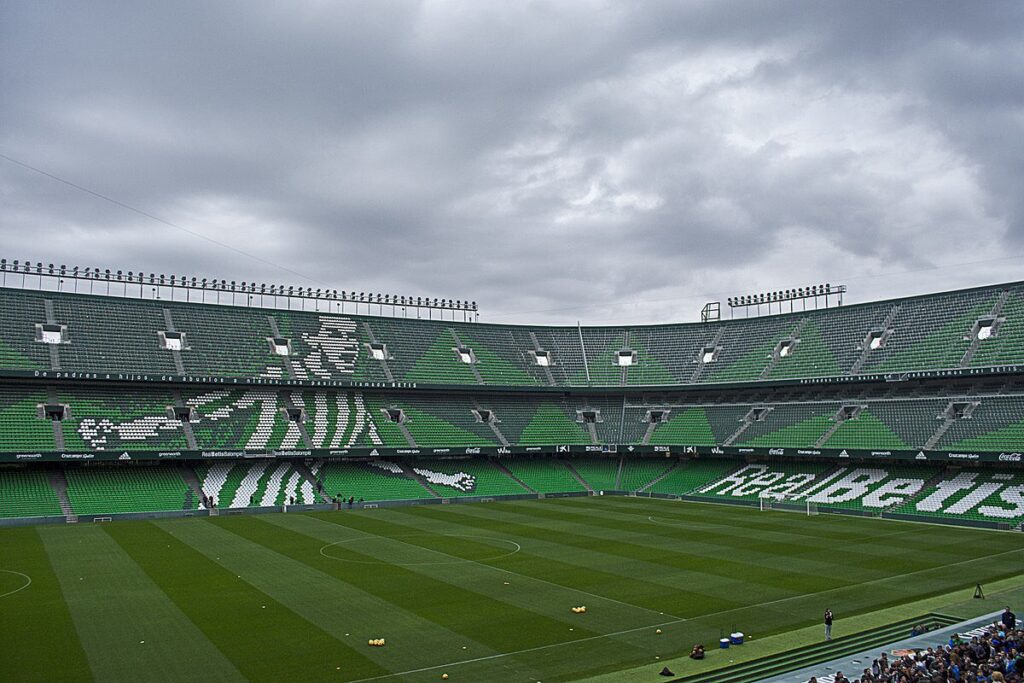
History of Benito Villamarín Stadium
Benito Villamarín Stadium was built in 1929 and was initially named Estadio de Heliópolis. It was later renamed in honor of the Real Betis Balompié president who oversaw the construction of the stadium, Benito Villamarín. Over the years, the stadium has undergone several renovations and upgrades to improve its facilities and modernize its infrastructure.
The stadium has hosted several major events throughout its history, including the 1982 FIFA World Cup and the 2003 UEFA Cup Final. It has also been the home ground for Real Betis Balompié during their most successful periods, including their Copa del Rey wins in 1977 and 2005.
Design and Architecture
Benito Villamarín Stadium has a unique and striking exterior design that incorporates both traditional and modern elements. The main stand is covered and includes several VIP boxes, while the other stands are open and exposed to the elements. The stadium has a capacity of 60,720 seats, with most of the seating arranged in a single tier. The playing surface measures 105 x 68 meters and is made of natural grass.
In terms of facilities, the stadium boasts several amenities for spectators, including restaurants, bars, and souvenir shops. There are also multiple access points for fans, with different entrances designated for different ticket categories.
Atmosphere and Fan Culture
The atmosphere at Benito Villamarín Stadium is legendary, with passionate Real Betis Balompié fans creating an electrifying and intimidating atmosphere for opposing teams. The stadium is known for its unique songs and chants, with the “Himno del Centenario” (Centenary Hymn) being one of the most iconic.
Before each match, fans gather outside the stadium to participate in pre-match rituals and traditions. These include marching to the stadium together, lighting flares and smoke bombs, and waving flags and banners in support of their team.
The role of Benito Villamarín Stadium extends beyond football, with the stadium playing an important role in the community of Seville. It hosts various cultural events throughout the year and is a symbol of pride for the people of Seville.
Events and Records
Benito Villamarín Stadium has hosted several memorable matches throughout its history. One of the most significant was the Copa del Rey final in 2005, where Real Betis Balompié defeated CA Osasuna to win their second Copa del Rey title. The stadium has also been the site of several high-scoring matches, including a 6-6 draw between Real Betis Balompié and Valencia CF in 1995.
Real Betis Balompié has a strong record at Benito Villamarín Stadium, with the team winning the majority of their home matches. The stadium has also witnessed several individual records, including Joaquín’s record for the most appearances in La Liga for Real Betis Balompié.
Sustainability and Environmental Initiatives
Benito Villamarín Stadium is committed to reducing its environmental impact and promoting sustainability. The stadium uses renewable energy sources such as solar panels to power its operations and has implemented recycling and waste management programs to reduce its carbon footprint.
In addition, the stadium has introduced several initiatives to reduce plastic waste and promote eco-friendly practices among spectators. For example, it has banned the use of single-use plastic bottles and encourages fans to use refillable bottles instead.
Technology and Innovation
Benito Villamarín Stadium has embraced technology and innovation to enhance the spectator experience. The stadium has installed Wi-Fi and mobile connectivity, enabling fans to stay connected during matches. It also uses digital ticketing and payment systems to make the ticketing process
capacity of benito Villamarín compaired to other stadium
Benito Villamarín Stadium has a capacity of 60,720 seats, making it one of the largest stadiums in Spain. However, it is not the largest stadium in the country, with several other stadiums boasting a higher capacity.
For example, the Camp Nou stadium, home to FC Barcelona, has a capacity of 99,354 seats, making it the largest stadium in Spain and the third-largest stadium in the world. The Santiago Bernabéu Stadium, home to Real Madrid, has a capacity of 81,044 seats, while the Wanda Metropolitano Stadium, home to Atlético Madrid, has a capacity of 68,456 seats.
Despite not being the largest stadium in Spain, Benito Villamarín Stadium is still a significant venue, hosting some of the most exciting matches in Spanish football. Its unique design, passionate fan culture, and commitment to sustainability and innovation make it a stadium worth visiting for football fans from around the world.
